How to deal with gooseberry moth during fruit ripening and other periods
The gooseberry moth, or wax moth, is a dangerous pest, the appearance of which in a garden plot threatens to destroy most of the harvest of fruit and berry crops. We will tell you in the article how to fight the gooseberry moth during fruit ripening and which plant varieties are most resistant to the pest.
Signs of gooseberry moth damage
The presence of the moth on gooseberries can be detected by examining the bush and berries.
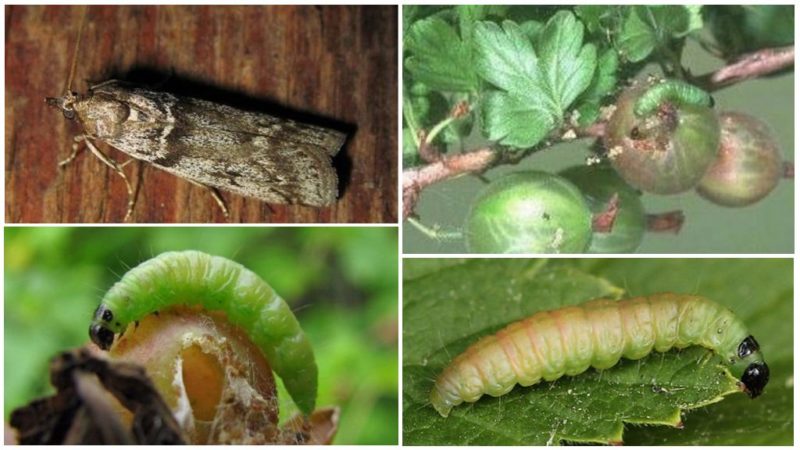
How to recognize a pest
The presence of an insect is detected by the following signs:
- the appearance of cobwebs on the plant;
- the formation of small holes on the berries through which thin threads of cobwebs pass, gradually entangling several fruits into a ball at once;
- coloring of berries ahead of schedule;
- decay, drying and fruit falling.
If you crush a intact berry from a cobweb-covered berry, inside, most likely, there will be a bright green caterpillar up to 1.5 cm long with a black head and ring-like spots - this is exactly what this pest looks like.
Attention! A characteristic sign of gooseberry damage by wax moths: its larvae (caterpillars) feed first on flowers, then berry pulp and seeds, while the peel remains intact.
Damage caused
In the absence of timely measures to combat wax moths, its larvae will soon be enveloped in cobwebs and spoil most of the fruits (from 50 to 90%), or even completely deprive the gardener of the entire harvest.
The caterpillars that are not destroyed will overwinter in the soil in the form of pupae, from which butterflies will emerge in the spring and lay eggs first in flower buds and then on the ovary, from where the larvae will crawl out again and devour the flowers, pulp and seeds.
Reference. The damage from one moth caterpillar is the loss of 6-7 large gooseberries.
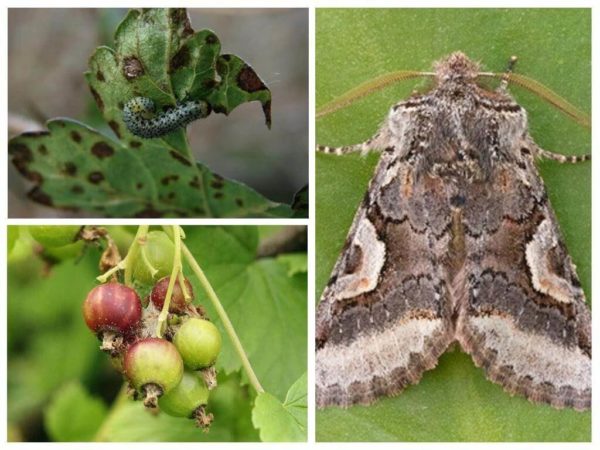
Causes
Reasons for the appearance of moth on gooseberries:
- the presence of a pest on currant or raspberry bushes growing nearby;
- dense plantings and irregular pruning of branches, which leads to a lack of lighting and air;
- lack of proper care of the garden plot (cleaning up fallen leaves, fruits and other plant debris);
- non-compliance with the rules of agricultural technology (timely loosening and digging of the soil, mulching);
- neglect of preventive measures processing, preventing plant damage.
Ways to get rid of moth on gooseberries
To combat the moth, gardeners use both traditional and chemical and other methods.
Chemicals
The use of chemicals, although toxic, is still the most effective method to help get rid of wax moths and their larvae.
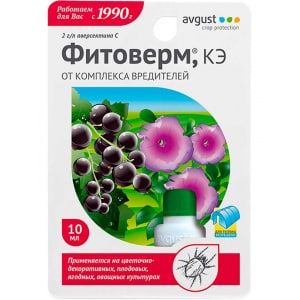
The most effective insecticidal agents from which solutions for spraying plants are prepared, following the attached instructions:
- the drug "Iskra M" is used in the evening, when wax moths are active, 1 tablet is dissolved in 1 tbsp. water and bring the total volume to 10 l;
- "Aktellik" (6 ml dissolved in 6 liters of water);
- “Fitoverm” (1.5 ml per 1 liter of water);
- "Fufanon" (0.2% solution);
- “Kinmiks” (0.05% solution) has a paralytic effect on the insect body both in the butterfly and larval stages, leading to the death of the pest a few days after treatment;
- “Karate” is used to exterminate the pest at all stages of its mobile development.
Plants are treated with toxic chemicals no later than a month before harvest.
Traditional methods
Folk remedies for pest control include weekly spraying of the bush with infusions prepared on the basis of plant components. The procedure is carried out 3 to 4 times.
Mustard infusion:
- 100 g of mustard powder is dissolved in 10 liters of water.
- Keep at room temperature for 2 days.
- Strain and add 2 more parts of water to 1 part of the resulting infusion.
From tomato tops:
- 1 kg of tops is poured with a bucket of water.
- Insist for 1 day.
- Filtered.
Zolny:
- Sift 1.5 kg of wood ash.
- Add 5 liters of water.
- Keep for 2 days at room temperature.
- Strain.
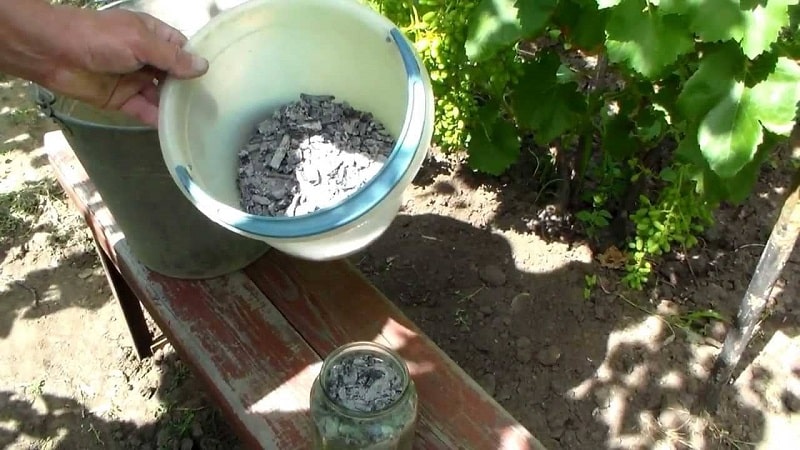
On chamomile:
- 100 g of dried flowers are poured into 10 liters of hot water.
- They insist for 2 days.
- The bushes are sprayed 4 days after the flowers have fully opened.
On tobacco:
- 400 g of tobacco dust (or shag) is poured into a bucket of water and left for 48 hours.
- Add another 10 liters of water.
- Spray once every 7 days during flowering.
With pine extract:
- Pine or spruce needles are poured with hot water (at the rate of 2 liters per 200 g).
- Keep covered in a warm place for 7 days, shaking once a day.
- Strain and dilute with water (1:10).
Wormwood decoction:
- Half a bucket of blooming wormwood is poured with a bucket of water.
- Leave for a day, then boil for half an hour.
- Cool and filter.
- Dilute with water in a 1:1 ratio.
Traditional methods of combating moth also include treating gooseberries and soil with a 12% aqueous solution of dust soap.If a week after the procedure you scatter about 50 g of dust powder under the bushes, the effectiveness of this treatment will increase significantly.
Another interesting folk method of eliminating a pest:
- A newly blossoming elderberry branch is cut off.
- Place it in the middle of a gooseberry bush to repel caterpillars with an unpleasant odor.
Agrotechnical techniques
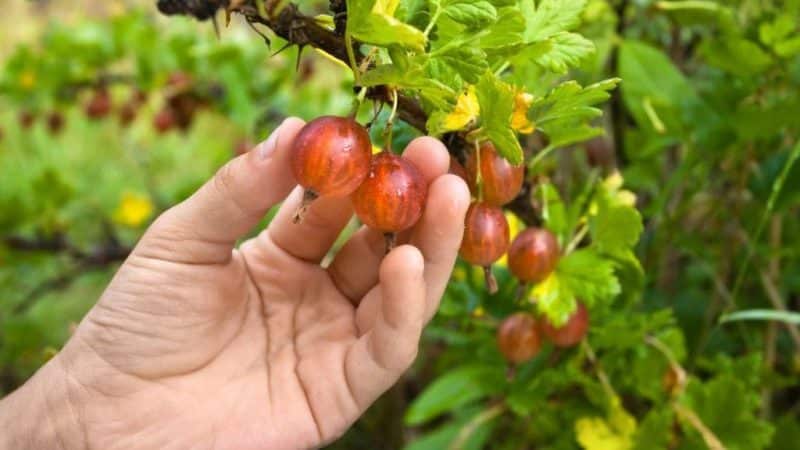 Agrotechnical rules:
Agrotechnical rules:
- When planting bushes, make sure to provide the gooseberries with a sufficient amount of light and air, leaving a distance between plants of at least 1 m.
- Carry out regular pruning of branches.
- Planting mint, tomatoes and elderberry bushes around the crop will act as a deterrent to the pest.
- After harvesting the fruits, the garden plot is thoroughly cleaned of all plant residues, burning them outside the garden.
- To destroy pupae that lie in the upper layers of the earth for the winter, the soil at the base of the bushes is dug up.
- To prevent butterflies from flying out of the cocoons remaining in the soil in the spring, before the onset of the first frost, the gooseberries are hilled to a height of 10-15 cm.
Mulching the soil around the bushes with compost or peat to a depth of 3-4 cm is also used to combat the moth. In the fall, after the leaves fall, it is enough to pour 2-3 buckets of mulch into the middle of the bush so that the pupae are neutralized.
Mechanical methods
Mechanical methods of combating moth:
- Spoiled and cobwebbed berries and leaves are manually collected from the bush into a separate container, and then doused with boiling water or burned.
- Special light catchers are made from yellow or orange cardboard coated with glue that takes a long time to dry, to which butterflies stick.
- Place traps with fermented sap near the bushes.
- Cover the soil around the bush with roofing felt or roofing felt to attract ground beetles that destroy the moth.
Features of pest control in different periods
Before flowering begins, in May, when buds begin to form and butterflies begin to fly, chemicals are recommended for use to combat wax moths:
- "Senpai";
- "Kinmiks";
- "Fufanon";
- "Iskra M"
- "Karbofos";
- "Gardona";
- "Etaphos";
- "Actellik" and other insecticides.
Among the folk remedies at this time, the use of pine infusion is effective.
During the flowering period, treat the plant with tobacco infusion once a week, and then, during egg laying, use:
- “Lepidotsid” (30 g per 10 liters of water);
- “Bitoxibacillin” (100 g per 10 liters of water);
- "Gomelin";
- "Agravertine";
- "Entobacterin" and other biological products;
- mustard infusion.
During fruit ripening apply:
- "Fitoverm";
- "Bitoxibacillin";
- folk remedies.
The use of safe drugs (Bitoxibacillin and others) is permissible even 5 days before the start of harvest. The treatment is carried out once every 5-7 days, and the berries are thoroughly washed after using these products.
In the fall, after harvesting, when the dormant period begins, the bush is treated with pesticides, as well as:
- they dig up the soil around the plants so that the wax moth pupae appear on the surface and die during the winter cold;
- cover the tree trunk circles with black agrofilm or a layer of mulch about 4 cm thick so that the larvae cannot get out of the soil and get onto the bushes.
Gooseberry varieties resistant to moth
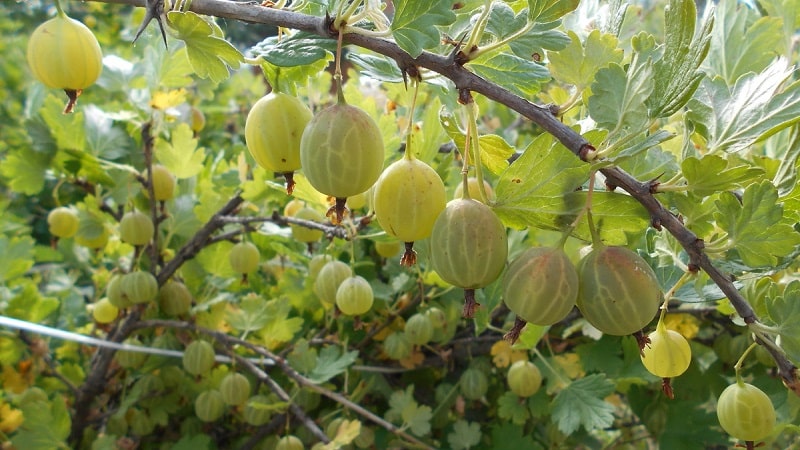
Some gooseberry varieties are resistant to moth damage:
- Universal variety Krasnoslavyansky It bears fruit with slightly pubescent large red berries, which have a pronounced pleasant aroma and high taste.
- Firework - one of the most productive varieties with dark red fruits, which, being fully ripe, remain on the branches for 2-3 weeks without falling off. The berries have an excellent taste, and there is practically no smell.
- Malachite refers to technical varieties of medium ripening period. Its berries are bright green in color, with thin transparent skin and delicate pulp.
- High-yielding mid-early variety Cossack with spreading bushes and thorny branches, bears medium-sized berries with a dark purple color and a dessert taste.
- Mid-late winter-hardy Chernomor It is characterized by high productivity and versatility of use. Its fruits are almost black, thin-skinned, and sweet.
Preventive measures
Measures taken in advance will help prevent the appearance of wax moth larvae on gooseberry bushes:
- Keeping the garden area clean, timely cleaning and destruction of broken branches, fallen leaves and fruit residues.
- Hilling bushes in late autumn.
- Mulching the ground around the bush with peat or compost.
- Covering the soil adjacent to the bush with plastic film.
- Watering the bush with hot water at the very beginning of spring, when the snow has not yet melted.
- Placement of bird feeders in the garden.
Digging up the soil at the planting site, followed by treating its surface layer with hexachlorane or a solution of nicotine or anabasine sulfate.
Helpful Tips and Mistakes to Avoid
Experienced gardeners share tips for combating moth:
- To reliably protect gooseberries from wax moths, it is also worth treating neighboring plants (currants, raspberries) that are susceptible to damage by these insects.
- Because the life cycle pest is 40 days, and the insecticidal preparations used to destroy it last no more than 20 days; the procedure for spraying gooseberries with chemicals is carried out 2-3 times.
- For treatment with insecticides to be highly effective, an integrated approach is needed, including parallel control of pupae located in the soil. To do this, use systemic agents (“Confidor maxi”, “Aktaru” and others), diluting the drug in water (8 g per 10 l) and watering the soil around the roots with the solution.
- Using an adhesive, for example, grated and dissolved laundry soap in water, when spraying will help the active substances remain on the leaves of the plant for a long time and act more effectively.
It is better to avoid the use of insecticidal preparations (systemic and contact) at air temperatures above +25°C, since in the heat their phytotoxicity increases, which leads to a negative effect on the human body.
Conclusion
Moth on gooseberries can bring a lot of grief to the gardener. However, using effective means of combating it, following the rules of agricultural technology, timely application of preventive measures, as well as growing varieties resistant to the pest will help get rid of the insect and preserve the harvest of juicy berries.